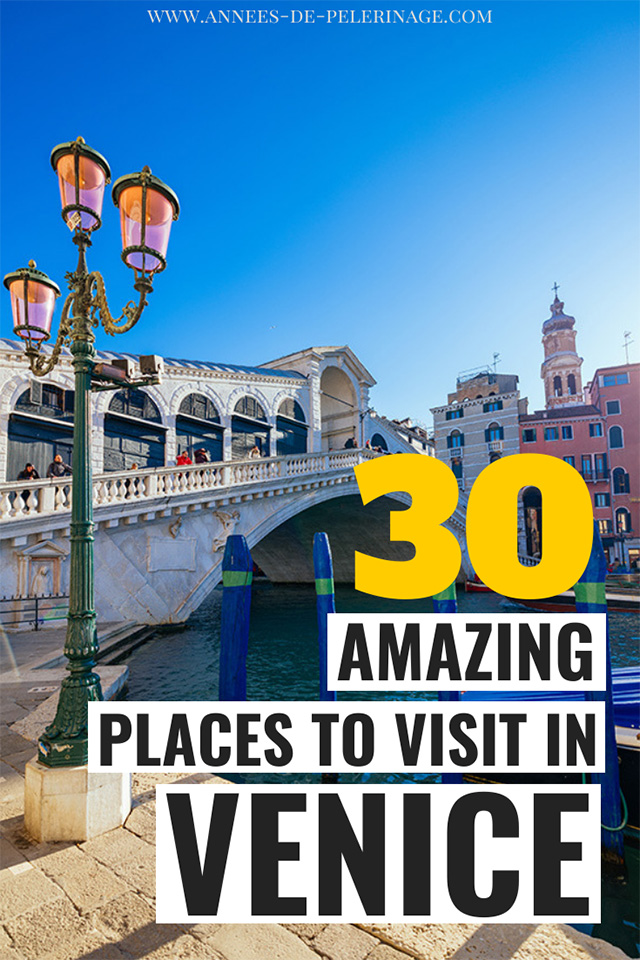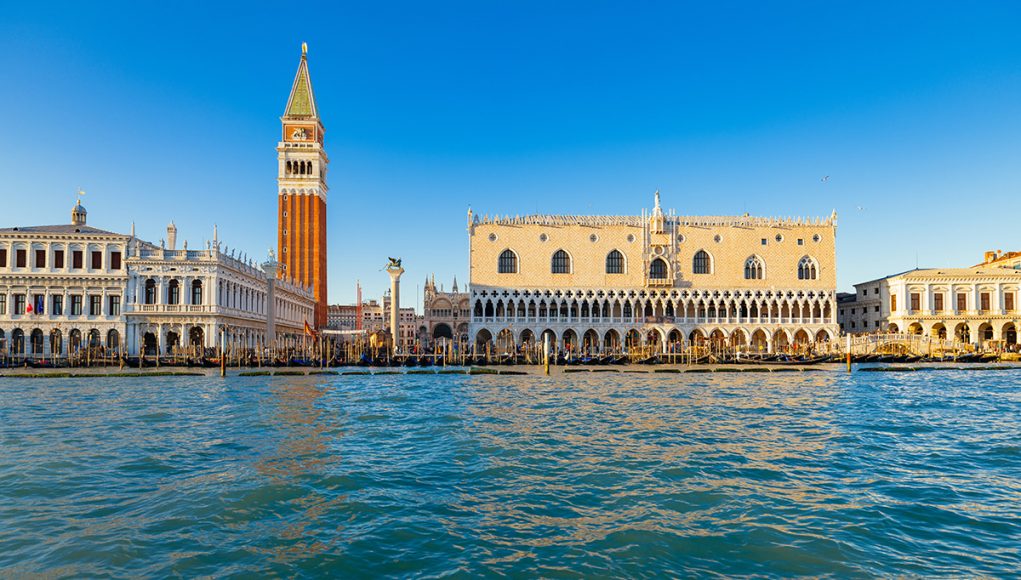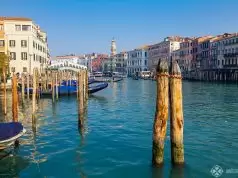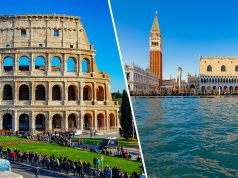Are you currently in the process of planning an amazing trip to Italy? And now you are wondering about the things to do in Venice? Well then, you came to the right place!
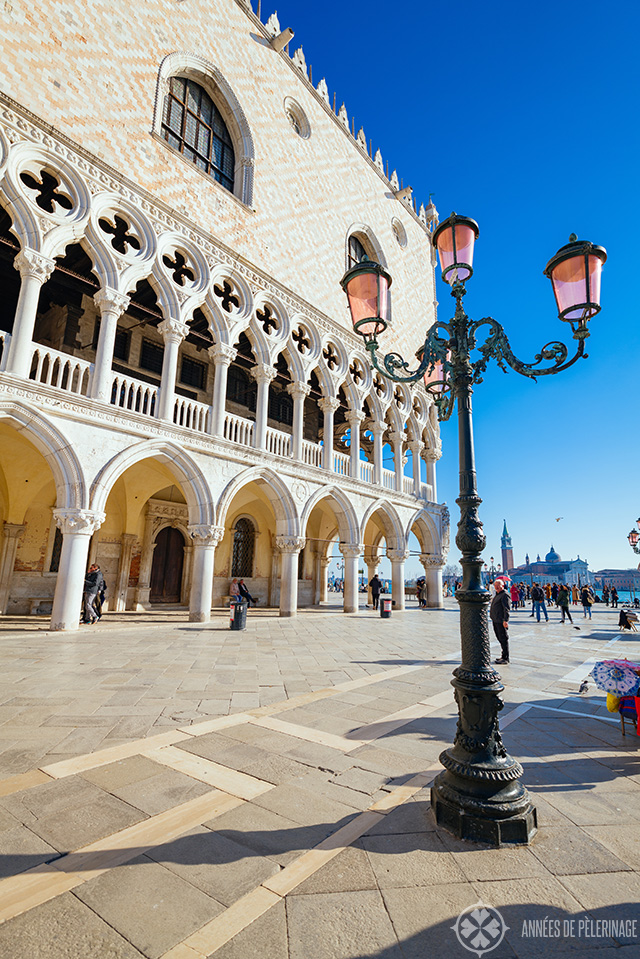
I have been to Venice four times already and almost every time I spend more than 3 or 4 days in La Serenissima (the other name for Venice). To me, it’s one of the most beautiful cities in the world, and I am sure you’ll see why I so highly think of the city after your first visit (Note: It is possible to only spend one day in Venice)
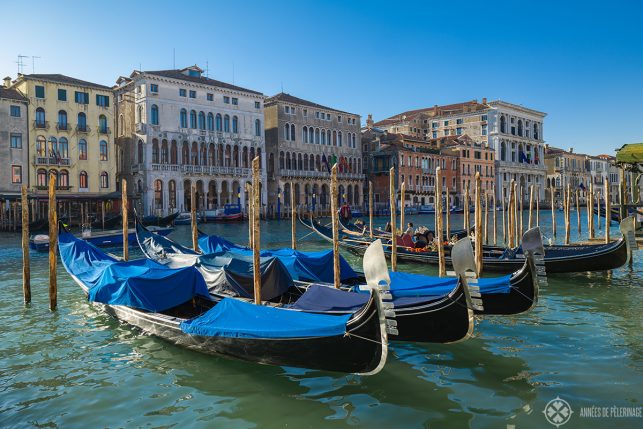
As there are so many tourist attractions in Venice, it sometimes can be a bit overwhelming. This is why I compiled a list of all the best places to visit in Venice for you. I tried to find a good mix of the most popular tourist attractions in Venice and my personal favorite spots. But before we go, I want to highlight three things:
First of all, there are many other beautiful places in Italy, and you should try to find a good balance in your itinerary. But most importantly: Venice offers a visible history of well beyond 1,000 years and even in 3 days you are not going to see it all. You really have to make a conscious effort to skip certain places otherwise it will get very stressful.
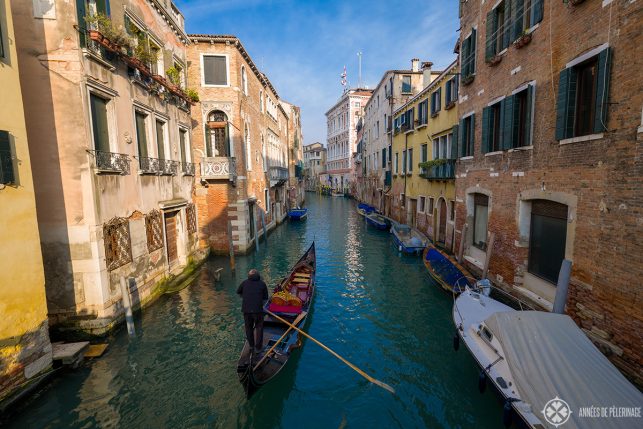
Speaking from all my previous visits, please consider that the very best thing to do in Venice is actually just walking around, crossing the many little bridges getting lost (here are some pictures to get you inspired). Don’t spoil your trip by trying to see every church and museum. Instead, let yourself drift along the amazing atmosphere of the capital of the Veneto region, eat an ice-cream and book a gondola ride.
Last but not least, you should consider getting the Venice City Pass. The day ticket for public transport is 20€ and the entrance fee to the Doge’s Palace is 25€, and most churches charge an entrance fee as well, so it really pays offs. Buy the city pass here.
Note: I earn a small commission for purchases made through links in this article.
The best places to visit in Venice
1. St. Mark’s Square
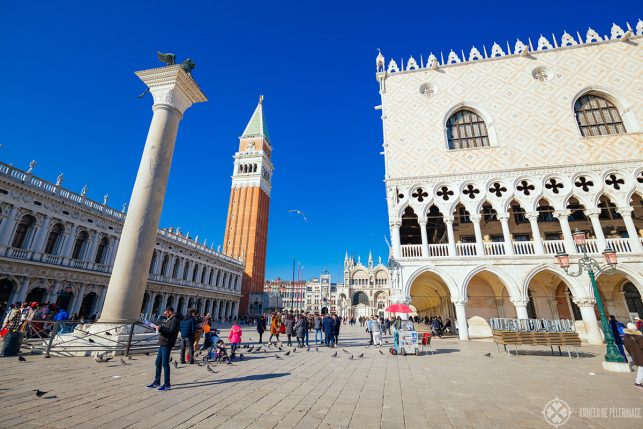
The Piazza San Marco is the main square of Venice and a true must-see. You’ll find most of the main attractions in the city lining the wide-open space in the heart of the city, but it is a highlight in itself. The current layout dates back to the 15th century, although it was a work in progress that started as early as the 11th century.
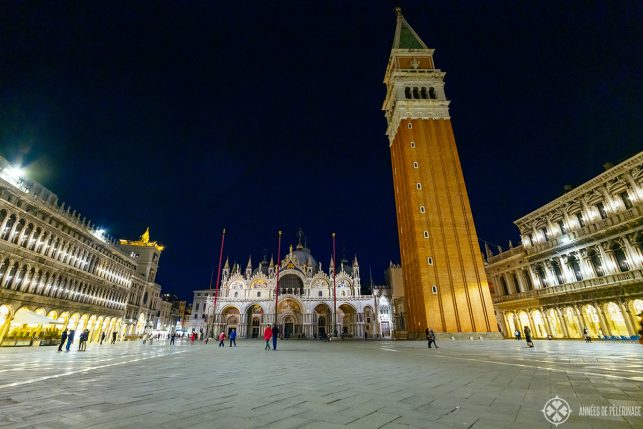
You’ll find many cafés around the square. Most famous of them all is probably the Caffé Florian – the oldest coffee house in the world (established in 1720). Prices at these places are very high, but I do have to say that sitting down on the square and breathing in the unique atmosphere is worth it.
The square is also famous for being inundated frequently by Acqua Alta (“high water) because the square is barely a meter above sea level. I have never experienced it myself, but when it happens they’ll install wooden walk-ways and things will get a bit more problematic.
Note: Don’t miss the amazing astronomical clock (Torre dell’Orologio) on the North exit of the square
2. Doge’s Palace
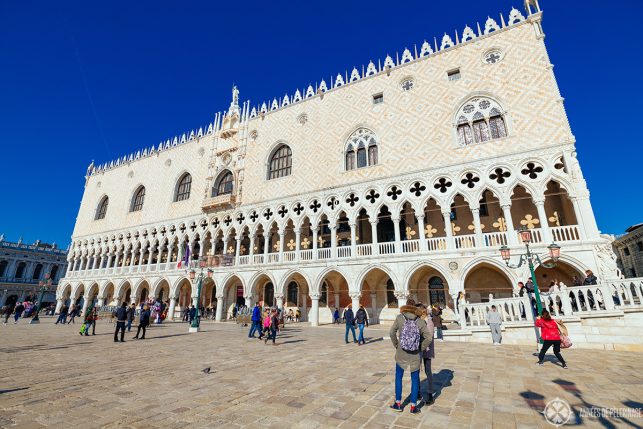
The main attraction on St Mark’s Square is the Doge’s Palace (Palazzo Ducale) from the 14th century. Ever since the 8th century and after the collapse of the Byzantine administration in Italy, the Republic of Venice was ruled by powerful Duke now commonly referred to as Doge (Doxe). The grand gothic palace you see today was the seat of this Venetian government ever since the dawn of the Venetian republic.

I cannot stress enough how amazing this palace is and you really should go inside. You see, the doge might have been the official ruler of the republic, but there were a lot of smaller councils who held the actual power. Each of them had a separate room inside the palace.
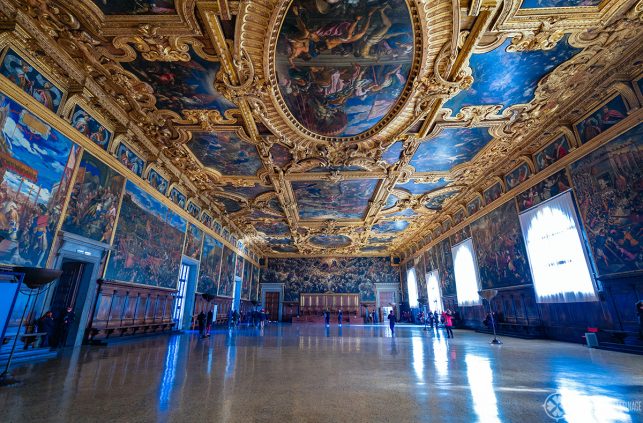
There is the Hall of the Full College, the Senate Chamber, the Chamber of the Council of Tens, the Chamber of the Quarantia Civil Vecchia and so on. Each and every one of these halls is absolutely enormous. The biggest of them all, the Council Chamber is 53 meters long 25 meters wide and counts as the largest room in Europe.
Every room and chamber is covered with impressive golden wood carvings from floor to ceiling, with important paintings by renowned artists like Tintoretto or Tiepolo. It’s truly remarkable and you won’t see anything even faintly similar anywhere else in the world
Note: Make sure to book your tickets in advance as there can be very long lines in summer. Consider booking the Secret Itinerary to see the most delicate rooms in the palace and tour the St. Mark’s terrace viewpoint.
3. Saint Mark’s Basilica
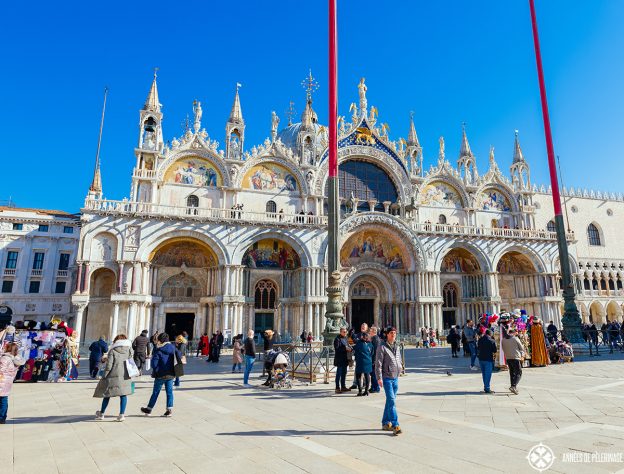
The patron saint of Venice is Saint Mark, which is now represented by a Lion with wings on every flag and public building. According to the legends, the body of the Evangelist was brought to Venice via Alexandria in the 8th century and a cathedral was built next to the Doge’s palace to house these important relics.
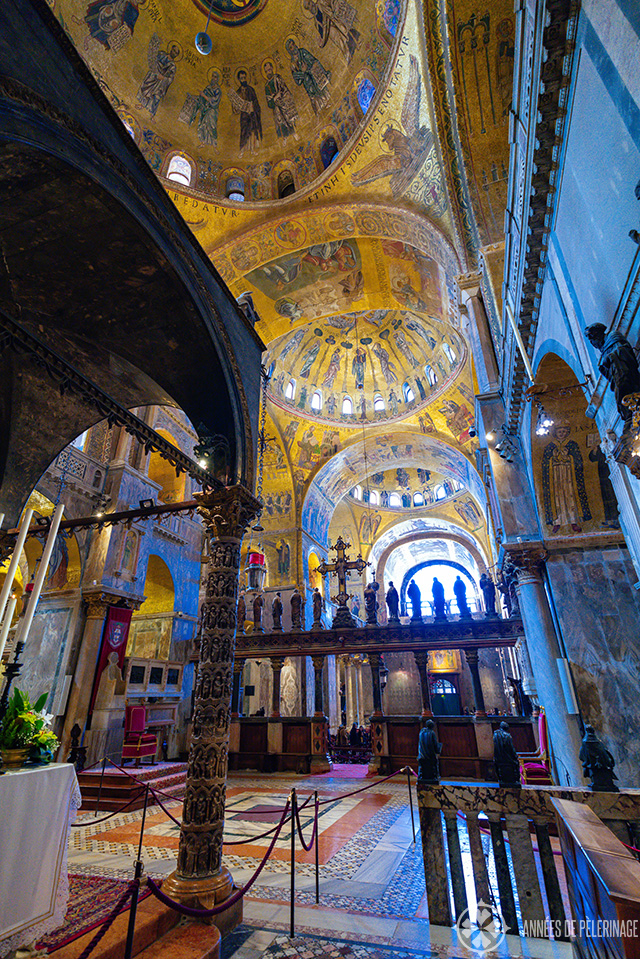
The current building dates back to the 11th-century, but the original plain brick building was given a beautiful gothic facade in the 13th century to match the look of the adjacent palace.
Inside, you’ll find outstanding medieval mosaics in gold. What makes the Basilica di San Marco so special is the unique mixture between Byzantine and Venetian style.
Note: The entrance to the cathedral is free. Only the treasury (3€) and the famous Pala d’Oro altar (2€) will cost an extra fee which I personally feel is worth it.
4. St Mark’s Campanile
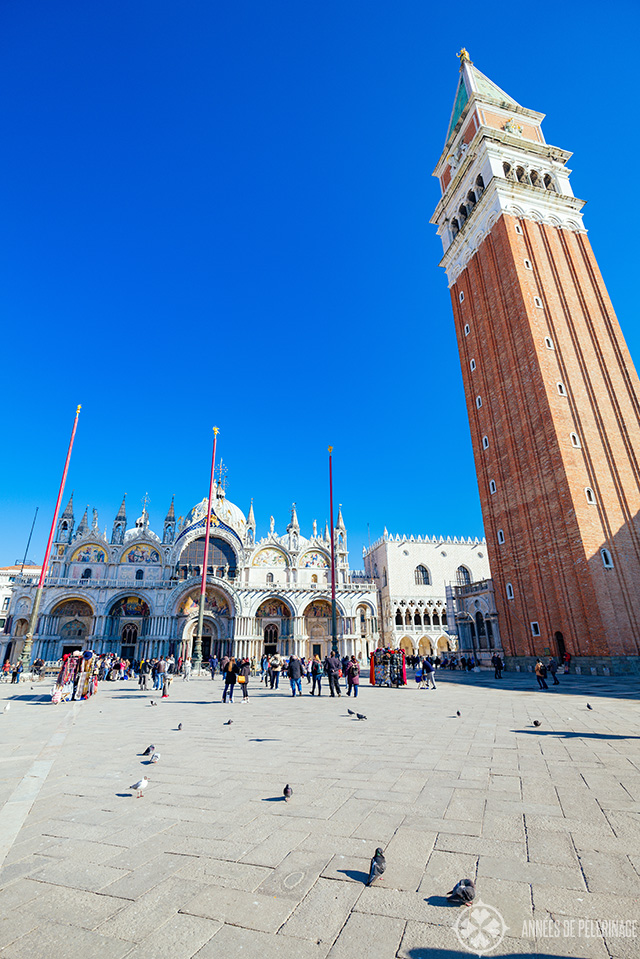
Looking for the best viewpoint in Venice? Well, then you absolutely have to climb all the way to the St Mark’s bell tower (Canpanièl de San Marco). The foundations for the tower were laid in the 9th century, but it was destroyed multiple times in history. In fact, it crashed down on the square in 1902.
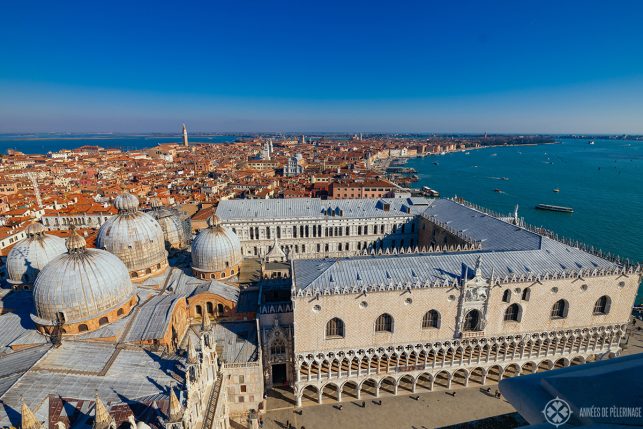
It was reconstructed faithfully by 1912 but reinforced internally to prevent any further collapse. Now, an elevator will get you to the top, but there are often long lines. It really makes sense to reserve your tickets in advance to avoid the queue. This service is only available between April and November. In winter, Venice is mostly empty.
Note: Read my list of the 15 top photo spots in Venice for further inspiration.
5. Rialto Bridge
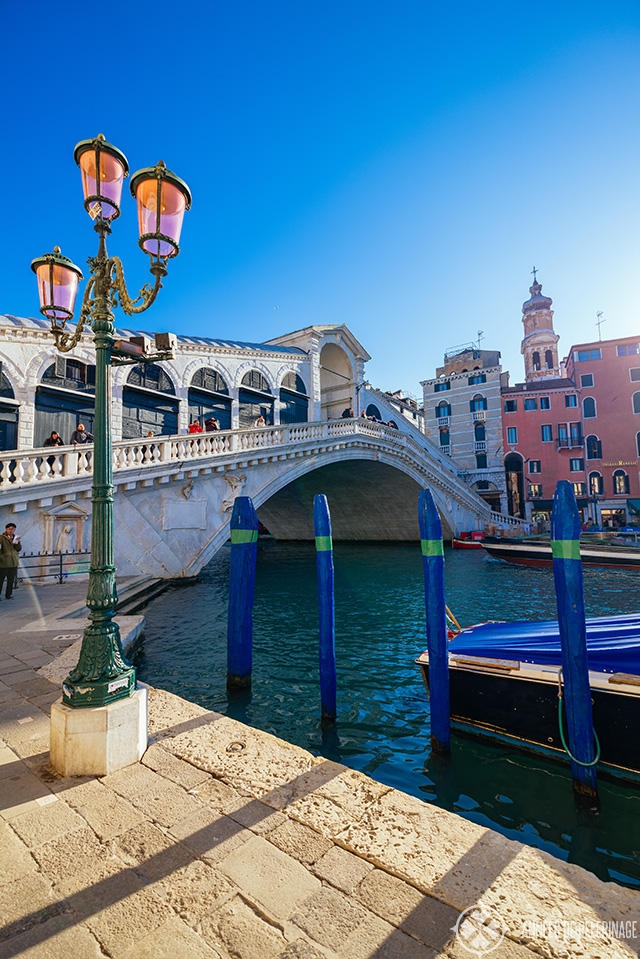
The Canal Grande splits Venice into two parts. Historically, the famous Rialto Bridge (Ponte di Rialto) from the 16th-century was the only dry crossing between the two parts. While gondoliers provided easy access to the various islands, the nearby Rialto market became so popular that a more permanent way to cross the bridge became necessary.
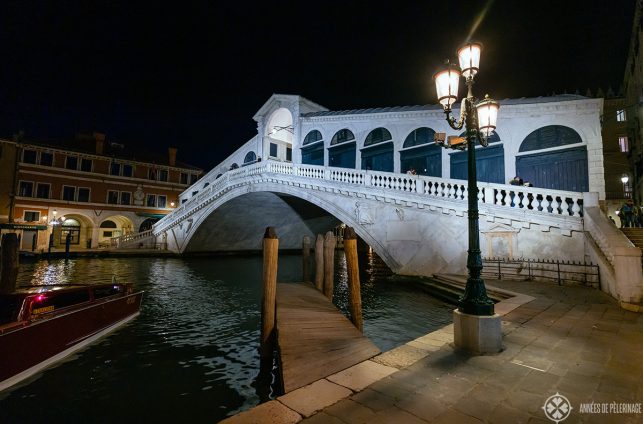
Shops are lining the tourist attractions and traditionally the rent was used to help maintain the bridge. These days, you’ll find 3 more bridges across the Grand Canal, but none of them are as big and beautiful as the Rialto Bridge. The best place to take a picture of the bridge is from a Vaporetto (water bus) or from the gondola piers to the side.
6. Scuola Grande di San Rocco
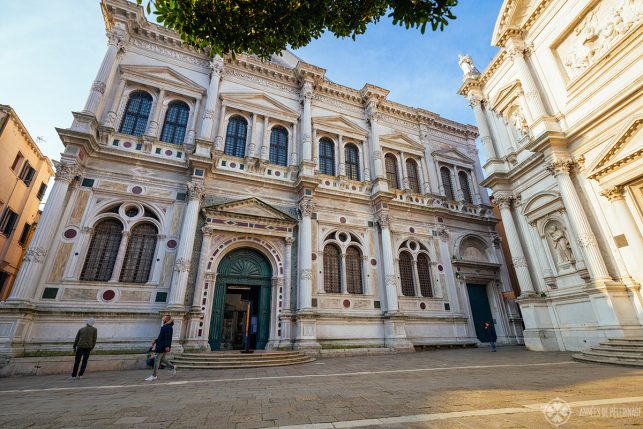
One of my personal favorite spots in Venice is the magnificent Scuola Grande di San Rocco. San Rocco was a particularly popular saint in Venice as he was regarded as a protector against the plague. The confraternity soon became one of the richest in the city and they decided to build a new chapterhouse in the 15th century which was finished by 1560.
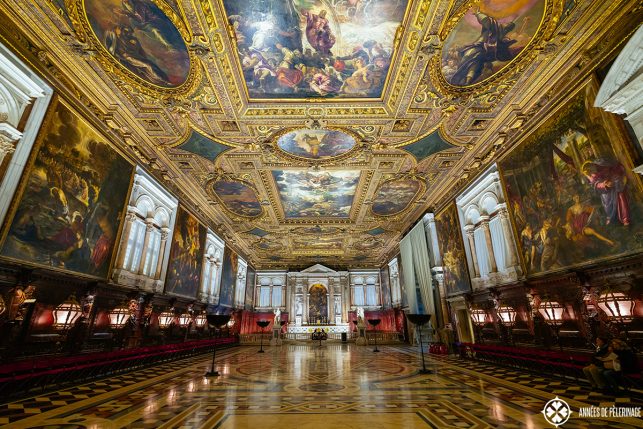
It is famous for its fast collection of paintings by Tintoretto and the grand hall on the second floor remained virtually unchanged throughout the centuries. I cannot even begin to stress how amazing this building is. Doubly so, as it is still one of the lesser-visited tourist attractions in Venice (for no reason whatsoever!).
7. Bridge of Sighs
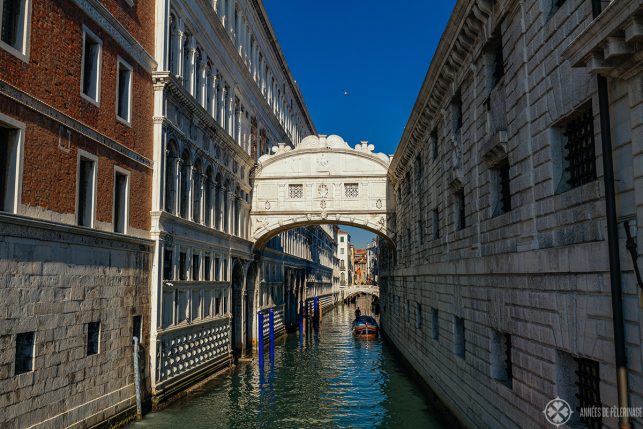
The most photographed tourist attraction in Venice? It’s probably the Bridge of Sighs (Ponte de i Sospiri). The ornate white limestone bridge connects the Doge Palace with the adjacent prison complex. The name is a 19th-century invention alluding to the fact that prisoners taken from their interrogation at the Doge’s Palace to their cells would sigh at their final view of Venice before they were executed.
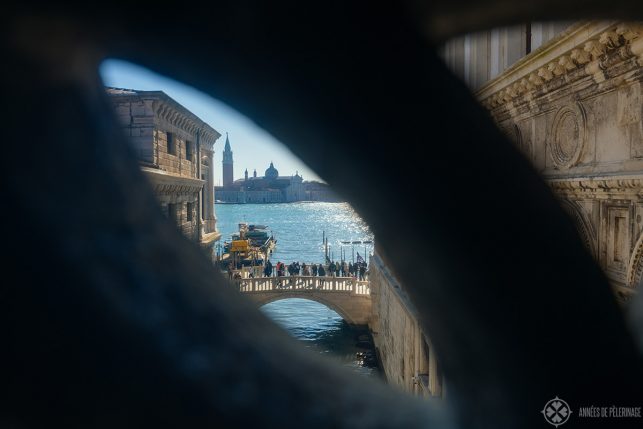
The name is a fabrication by Lord Byron. If you do the tour of the Palace, you will eventually cross the bridge, but there is little to see through the tiny windows. Also, by 1600, when the bridge was finished, the days of the inquisition were long gone. It remains without a doubt, however, that the bridge IS beautiful.
9. Grand Canal (take a Vaporetto)
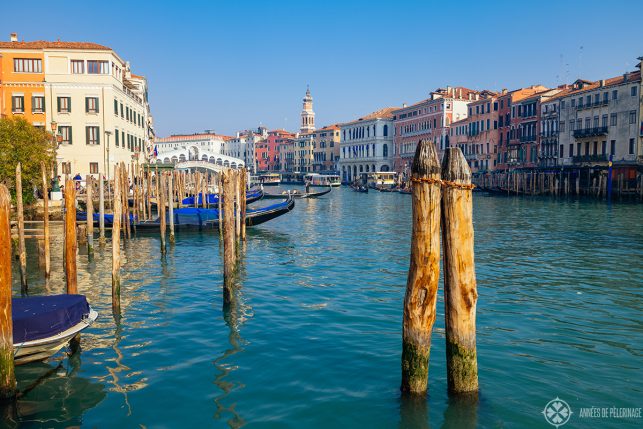
Ask a hundred tourists and I bet the vast majority will agree that simply taking a Vaporetto (water bus) from the train station to St Mark’s square is the most amazing thing to do in Venice. Along the Canal Grande are some of the most beautiful palaces in the city.
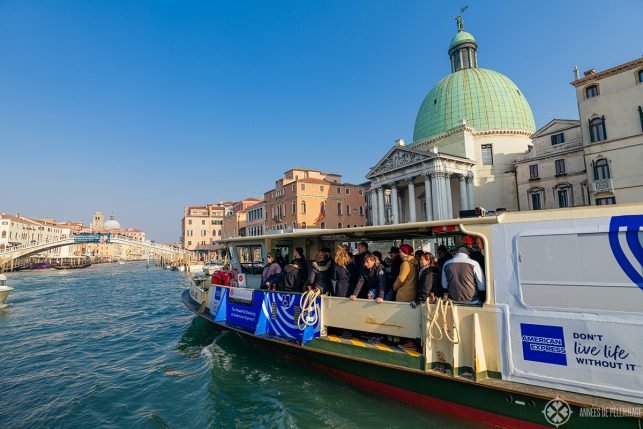
Also, driving through the beautiful Rialto bridge is nothing short of spectacular. Ever so often you will see gondoliers showing tourists their city or water taxis bringing the well-to-do to their luxury hotels. A single ticket costs 7.50€ but you are probably better off getting a day ticket for 20€ for unlimited rides. It’s really worth it and quite easy to use and by far the best way to tour the Grand Canal.
10. Gallerie dell’Accademia
There are many museums in Venice. I personally love museums and still I feel you should invest most of your time exploring the city and not stay inside all the time. There is one exception: The Gallerie dell’Accademia houses the most important collection of Venetian art in the world.
You can see some amazing masterworks from Tintoretto, Bellini, Giorgione, Veronese or Titian inside. The collection also includes Leonardo da Vincis famous drawing ‘The Vitruvian Man’ (but it’s not always on display). Still, don’t skip this!
11. Church of San Giorgio Maggiore
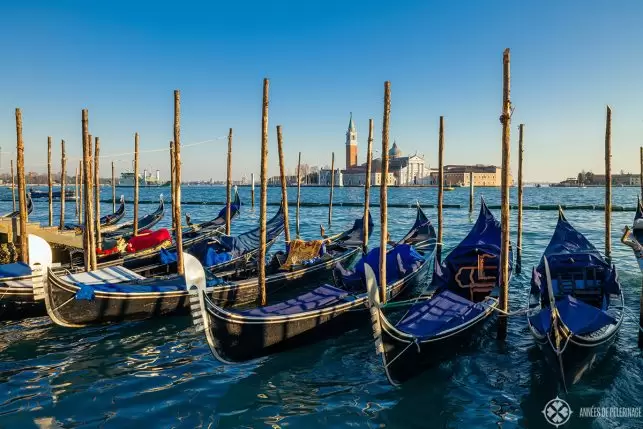
I am not sure someone ever counted all the churches and smaller chapels in the Veneto region. There are just so many of them and most of them are quite amazing. As a tourist, you can’t visit all of them, but you should definitely make time to take a water bus over to San Giorgio Maggiore.
You’ll find it right across the lagoon from St Mark’s Square. The church houses some important works by Tintoretto and Bassano, though you will find the interiors to be quite austere compared to other churches. It was given to the Benedictine order in the 10th century and remains in their hand ever since.
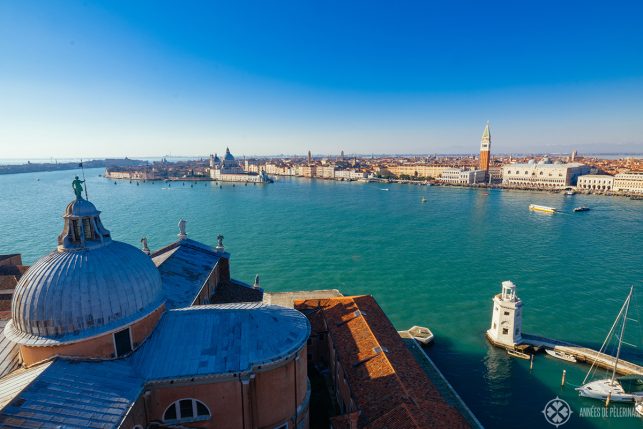
The main reason to go there is actually the outstanding view of Venice from the bell tower. It’s the only spot where you can actually see the whole lagoon.
12. Peggy Guggenheim Collection
I’m aware that not everyone likes old-masters. Venice is full of them. If you want to see an outstanding collection of European and American art of the first half of the 20th-century, then absolutely head to the Peggy Guggenheim collection. It was her personal collection and is now run by the Guggenheim Foundation. It’s quite a beautiful building with a little sculpture garden.
13. Teatro la Fenice
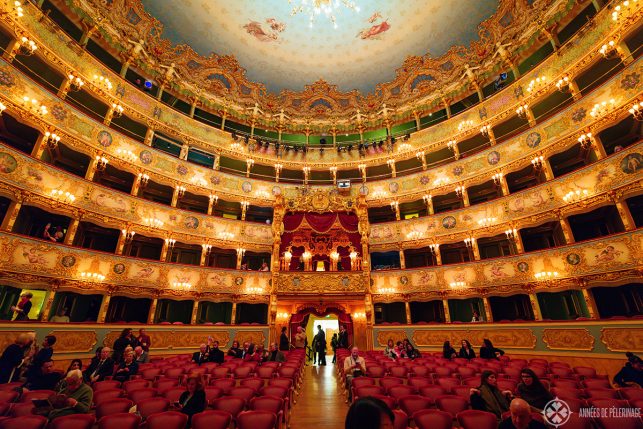
You can’t separate the opera from Italy, nor the opera from Italy. So, grab the chance and visit the beautiful Teatro la Fenice in the heart of the city. My recommendation is booking tickets for a performance at night, but you can also do a tour of the theater during the day (as long as there are no performances scheduled). I might be partial, but I loved it!
14. Visit Burano
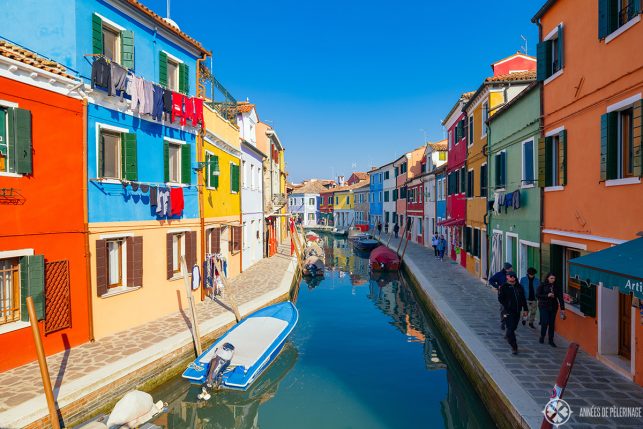
It’s easy to forget Venice is more than just one city. Before the formation of modern Italy in 1870, Veneto was it’s very own independent republic and Venice was “only” the capital. There are many other beautiful points of interest in the lagoon and the tiny island of Burano might just be its crown jewel.
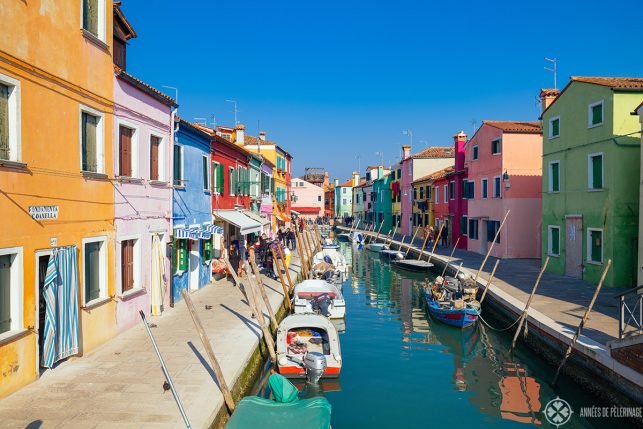
The whole island looks a bit like a puppet house version of Venice. There are only three water channels and the colorful houses have only two or three stories. But let me tell you, it is so beautiful! The island is also famous for its lace and there is even a Lace Museum on Burano.
Note: There are regular ferries from the Fondamente Nove station to Burano (like every 20 minutes) but do take into consideration it takes about 40 minutes to get there.
15. Basilica di Santa Maria della Salute
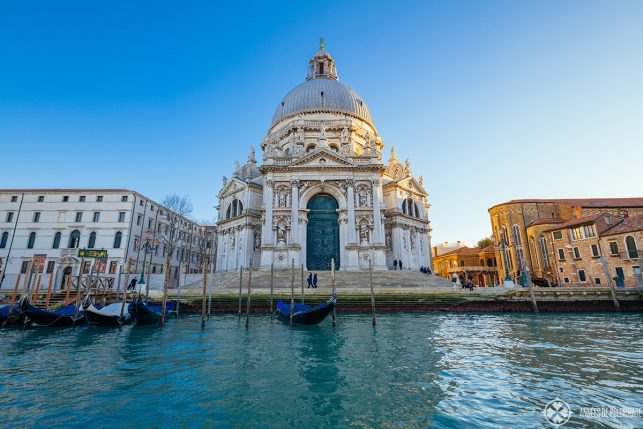
At the very end of the Canal Grande, you can’t help but notice an imposing church. Santa Maria della Salute appears on a lot of Venice postcards and it really makes sense to cross over to the other side and take a beautiful picture.
16. Palazzo Contrarini del Bovolo
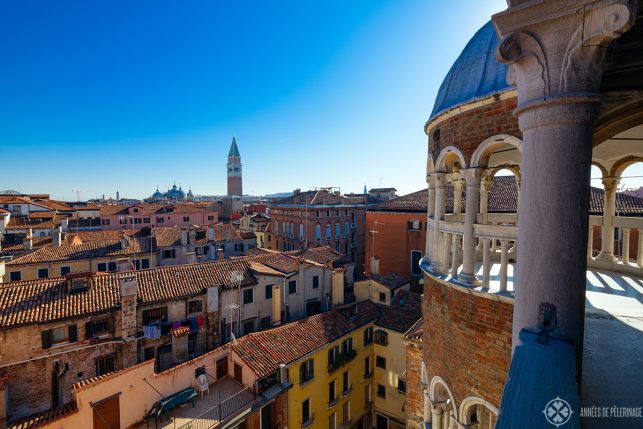
Are you looking for a unique viewpoint in Venice? Then head to the remains of the Palazzo Contrarini del Bovolo (also known as Scala Contrarini del Bovolo). It’s an ancient Venetian Palace from the Renaissance time but little but the exterior stair remains.
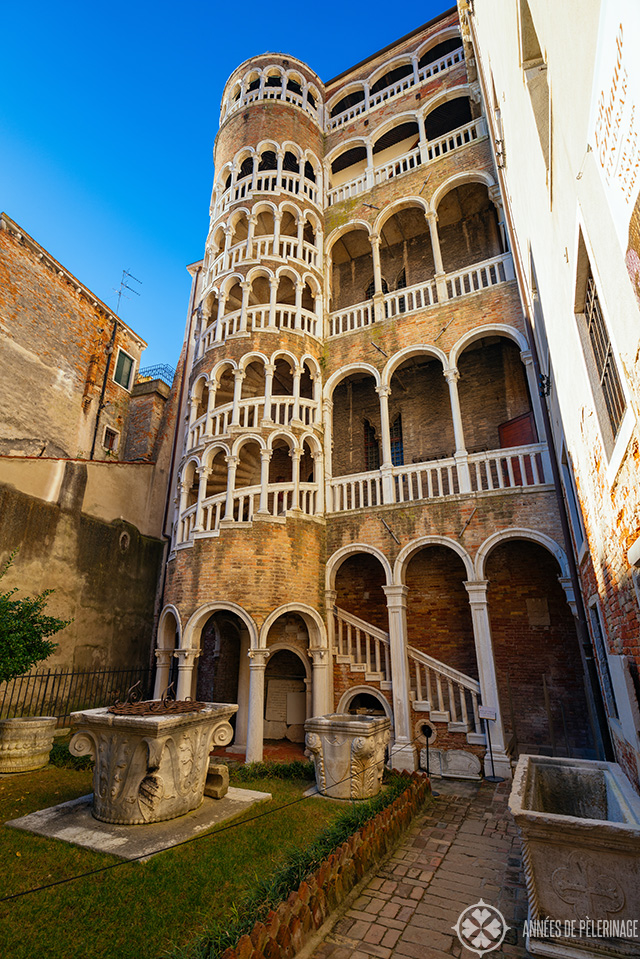
From the top, you can easily see St Mark’s Square and it really is a beautiful photography spot.
Note: The entrance fee is 7€ and it’s not covered by the regular city pass. You can take a picture from outside for free, though.
17. Isola di San Michele / Cemetary
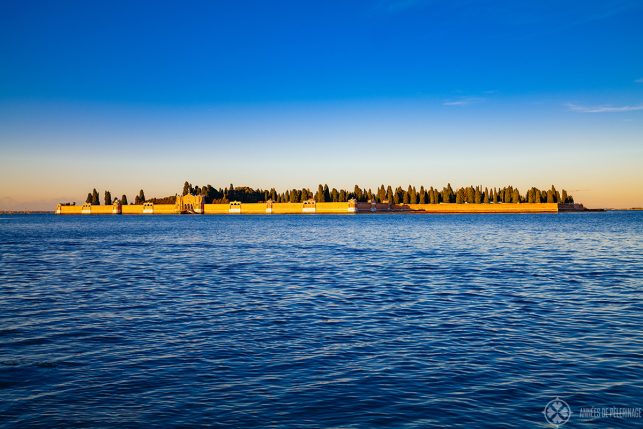
How do you bury people when the ground is frequently flooded? Most people in Venice are catholic, so burning the deceased is not an option. Other than in the crypts of the churches, you won’t find a single graveyard in Venice. Instead, there is a separate island right between Venice and Murano that was turned into one big graveyard.
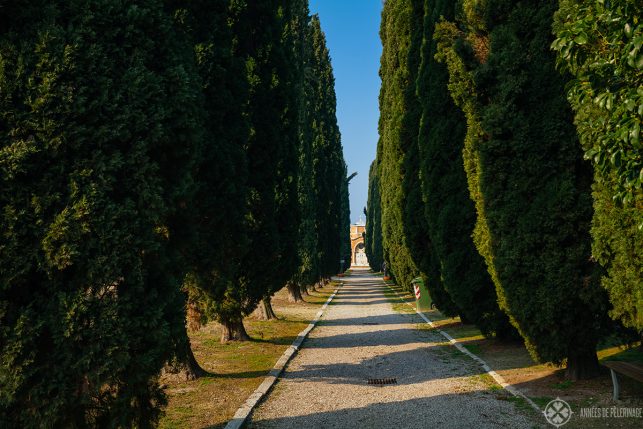
I personally love the way the setting sun reflects from the red brick walls around the island. It only takes 5 minutes to get there from Fondamente Nove, but to be quite frankly there is not much to see. There are very few big crypts and tombs, just endless rows of regular tombstones, but it is still interesting.
Note: Igor Stravinsky was buried here. So, if you are a fan of his music, I guess it’s a must-visit ;-)
18. Biblioteca Nazonale Marciana / Museo Correr
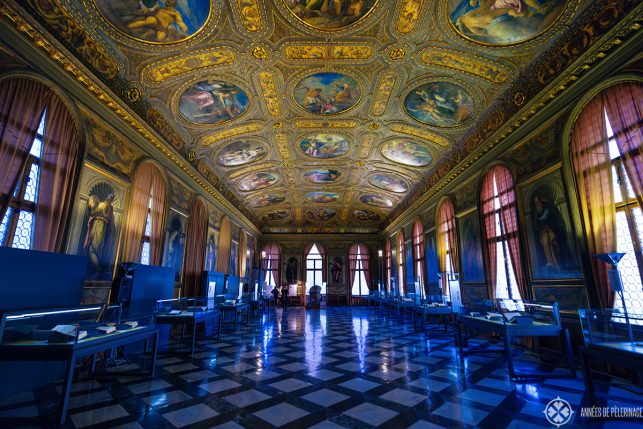
I already mentioned a couple of highlights on St Mark’s square, but you should definitely consider visiting the Museo Correr as well. You’ll find it in the buildings around the square (the so-called Procuratie) and it’s actually a complex with a couple of different collections.
My personal favorite (and certainly the highlights of this museum) is the Biblioteca Nazonale Marciana. The old reading hall of the library is nothing short of stunning, but the old ballroom of the palace is quite noteworthy as well!
19. Basilica of Santa Maria Gloriosa dei Frari
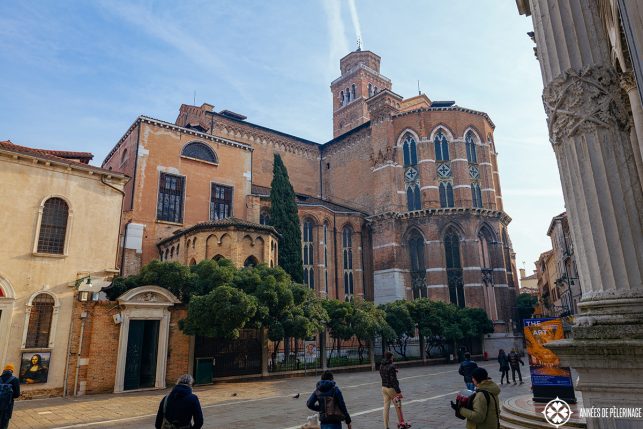
My personal favorite church in Venice? By far the Santa Maria Gloriosa dei Frari. There are a couple of outstanding masterworks by Titian and Bellini inside and it’s hard not to fall in love with this place.
I love the Canova Monument the most, though. The ancient memorial to the famous Italian sculpturer is out of this world and probably ranks among the most beautiful tombs in this world (you’ll find another version of this tomb in Vienna).
20. T Fondaco dei Tedeschi by DFS
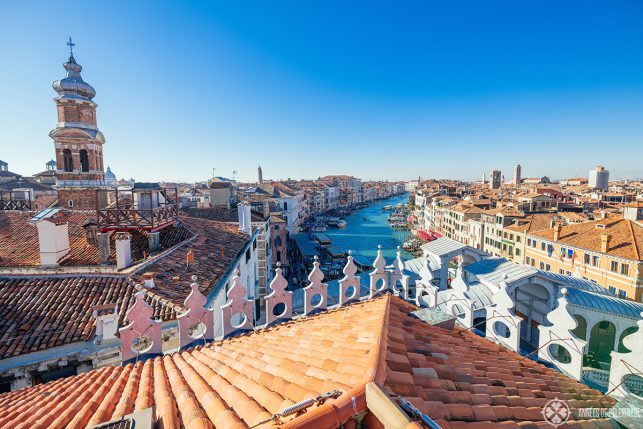
Do you like shopping? Then the T Fondaco dei Tedeschi store close to the Rialto bridge is your best bet to splurge on Italian designer fashion. But that is actually not the reason I am mentioning the department store. The real reason is the amazing rooftop terrace of the palazzo.
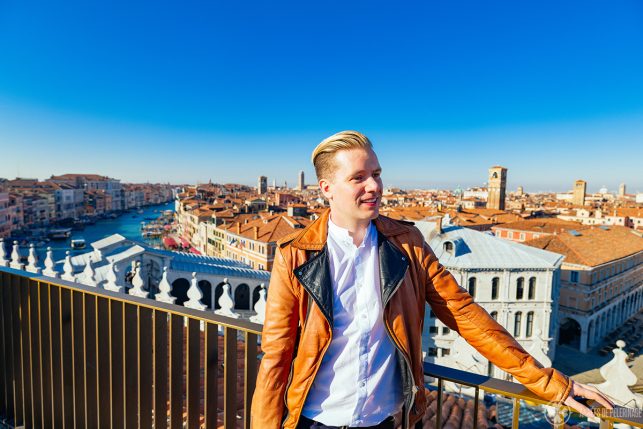
From here, you can enjoy one of the best views in Venice and certainly the best view of the Canal Grande. It’s a very popular viewpoint and you have to reserve your tickets in advance. Best be here early in the morning. It is worth it!!
21. Venetian Arsenal
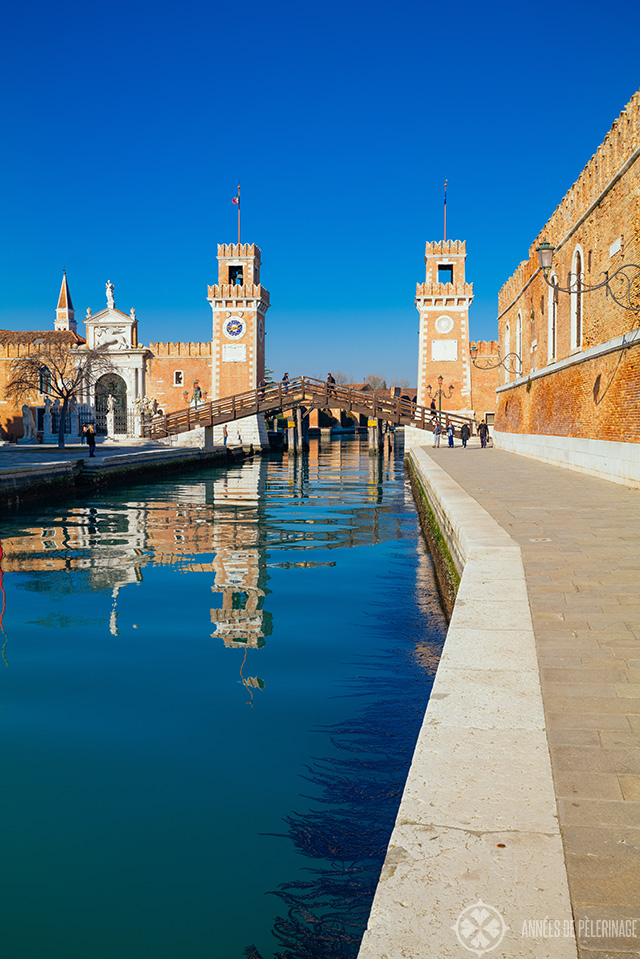
The Republic of Venice became so wealthy because the Venetians were the biggest naval power in the Adria and dominated all trade between western and eastern Europe. Even today, there is a big naval shipyard in Venice.
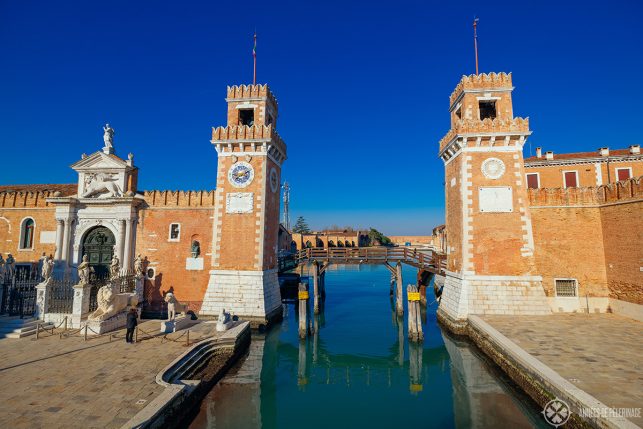
While you cannot actually go inside, it’s still a beautiful spot. If you follow the pier from St Marks square further outside, you’ll see two mighty turrets marking the entrance to the Venetian Arsenal. In ancient times, galleys were mass-produced here and it counts as the single largest industrial complex in Europe prior to the Industrial Revolution.
22. Museo di Storia Naturale di Venezia
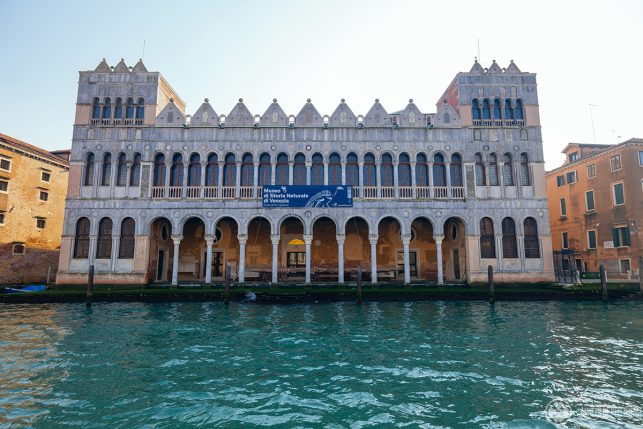
The Museo di Storia Naturale is one of the quirkier museums in Venice. You’ll find it in the beautiful 13th-century palazzo of the Pesaro family and it houses a wide range of botanical, zoological and entomological specimens. It’s certainly not a must-visit, but for longer stays in the city, it might add a little bit of diversity.
23. Ponte dell’Accademia
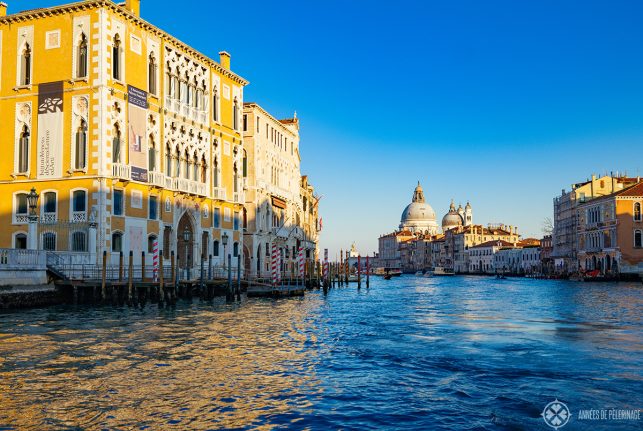
I already mentioned a couple of outstanding viewpoints but one is still missing: The Ponte dell’Accademia. It’s the last bridge before the Canal Grande enters the lagoon and you’ll cross it on your way to the Peggy Guggenheim Collection and of course the Gallerie dell’Accademia which gave it its name.
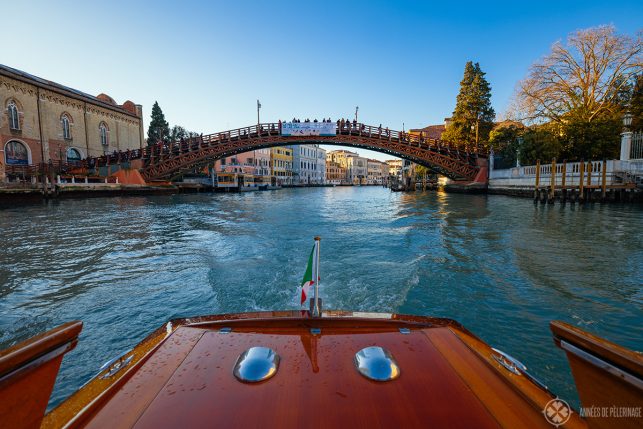
The bridge itself is quite unremarkable, but the view towards Maria della Salute is amazing. The best time to be here is in the afternoon.
24. Santa Maria dei Miracoli, Venice
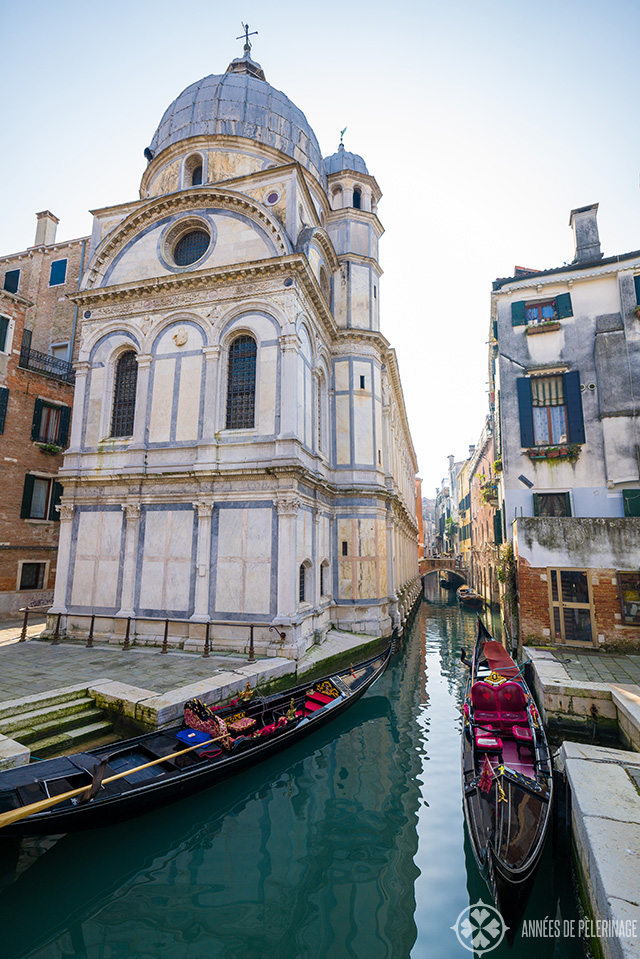
Colored marble everywhere you look – the Santa Maria dei Miracoli is named after the miraculous icon of the Virgin mary it enshrines. It’s probably the best example of the early Venetian Renaissance and worth a little detour.
The shape, a single nave covered by a barrel vault, is quite noteworthy as well. It’s like a condensed version of everything Venetian.
25. Royal Gardens
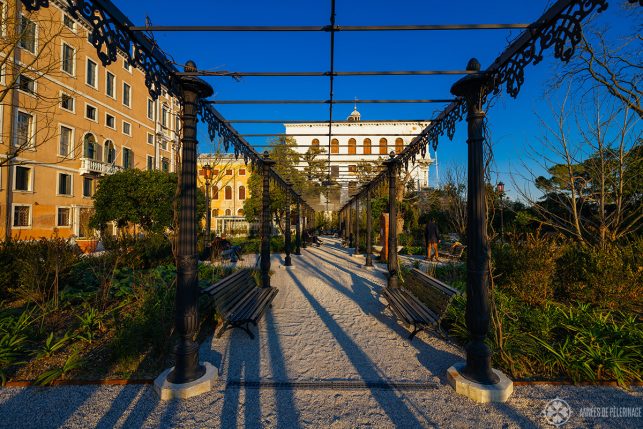
Venice might not be particularly famous for its gardens, but that doesn’t mean you shouldn’t visit the Giardini Reali di Venezia. Just follow the pier in front of the Doge’s Palace towards the East and you cannot miss it. It’s a small garden, but the little gazebos and covered corridors offer a welcome respite from the heat in summer.
26. Visit Murano
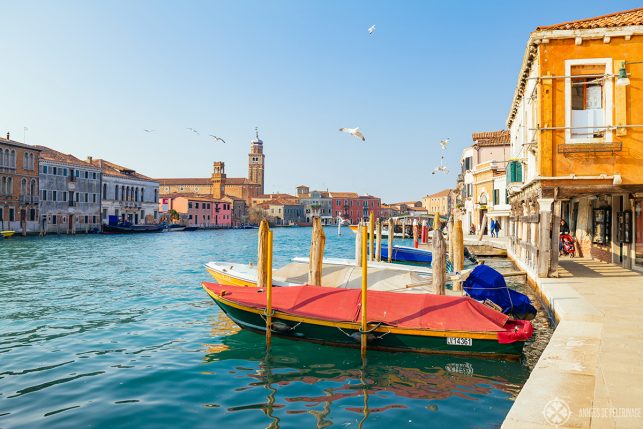
Venice’s impressive naval power was not the only reason for the fabled wealth of the city. For quite a long time they also held a quasi-monopoly on glass production in Europe. The reason they were able to keep the manufacturing process secret for so long was the unique location of the industry.
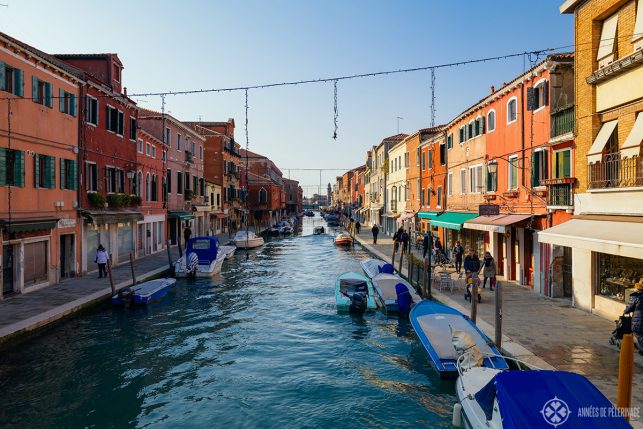
Ever since 1291, all glassblowers were moved to the adjacent island of Murano. Bestowed with extraordinary privileges but unable to really leave, it created a unique trade center that stimulated the invention of ever new techniques and glass variants.
Here they produced everything from glass bottles to luxurious chandeliers. When the Venetians invented the first completely clear glass (the so-called Cristallo Veneziano) in the 15th century the demand explored exponentially. Today, there are still quite some important glass manufactories on Murano and there is even a Glass Museum.
I personally love Murano because it is a lot like Venice, but much more tranquil.
27. Visit Torcello
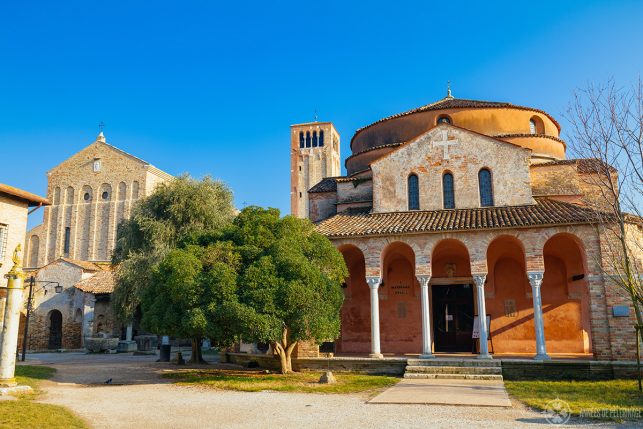
Torcello is another island in the Venetian lagoon not many tourists visit. In fact, there are barely any houses left on the small island. What most people don’t know: Venice was actually populated from here. Torcello was first settled in 452 AD. For quite a long time, the small city was actually much more powerful than Venice itself.
Today, not much of its former glory remains. After the swamp area around the island increased, people began to abandon Torcello. Most of the palazzi, churches, and cloisters were pillaged for their building materials and only the Cathedral of Santa Maria Assunta, founded in 639, remains. The parish church is quite the highlight, though. And the view from the bell tower is just as amazing.
28. Casino of Venice
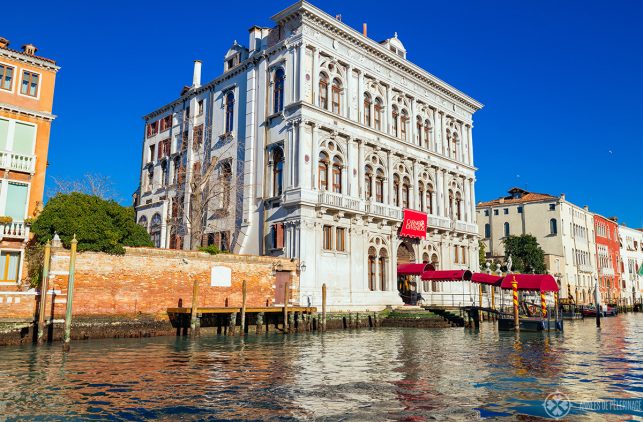
Inaugurated in 1638, the Casino di Venezia is actually the oldest casino in the world. If you are still looking for things to do in Venice at night, then this should be on your list. You can gamble there, but you might as well just go for dinner. They also have frequent events (especially during carnival).
29. Ca’ D’oro
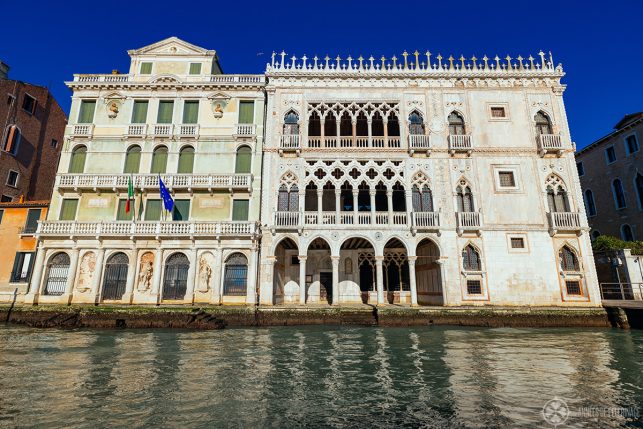
If you want to explore an authentic gothic palace, then you have to visit the Ca’ D’oro (“golden house”). You’ll find the Galleria Giorgio Franchetti museum inside now, but it was originally built in the 15th-century and is a prime example of the Venetian Gothic style. So beautiful!
30. Basilica dei Santi Giovanni e Paolo
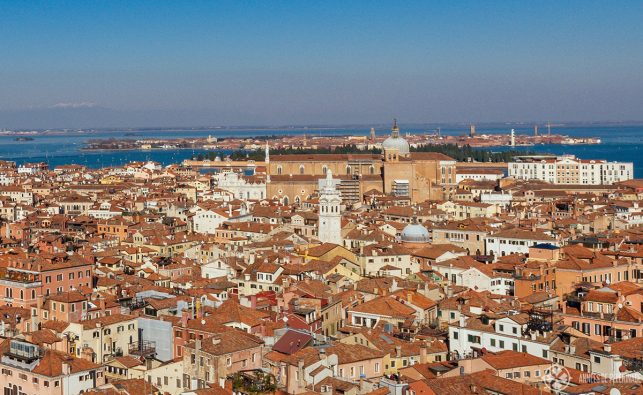
The last item on this list of things to do in Venice is the beautiful Basilica di San Giovanni e Paolo. It’s the third-largest church in Venice and altogether twenty-five doges were buried here. I particularly love the little Capella del Rosario with its beautiful ceiling paintings by Veronese.
Other things to see in Venice
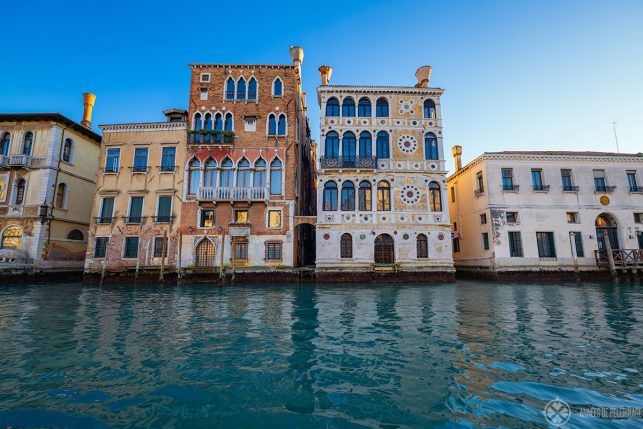
I want to be quite honest with you: I could easily visit 20 more beautiful tourist attractions in Venice. But at the same time, even covering this list will probably take you more than 4 days. Most tourists barely stay a day, so I decided against it. Still, you should be aware that I did not mention the Jewish Ghetto (the first in Europe).
I did not mention a couple of beautiful palazzos either. Most noteworthy perhaps the Palazzo Dario and the Mocenigo Palace-Museum. The Palazzo Grimani di San Luca is very famous and the Grassi Palace is also frequently mentioned among the must-sees in Venice
Then, of course, there are many other churches you could check out. I Gesuiti is very famous and so is the Chiesa di San Zaccaria with its beautiful altarpiece by Giovanni Bellini.
It also bears mentioning that the Lido is not very far away (only 20 minutes by boat) and you can easily spend a day at the beach there.
A lot of people also forget that Venice actually has landside as well. Here you could visit the UNESCO World Heritage site Palladian Villas of the Veneto (like Villa Foscari).
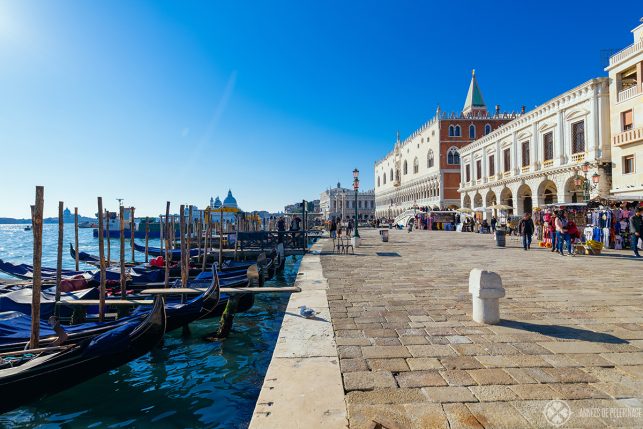
I started this guide by saying the best thing to do in Venice is letting yourself drift, and I’ll end it repeating myself. Just hit the alleys and walk onwards. Thanks to google maps, your real chances of getting lost are slim and you are bound to see something amazing on the way!
Best time to visit Venice
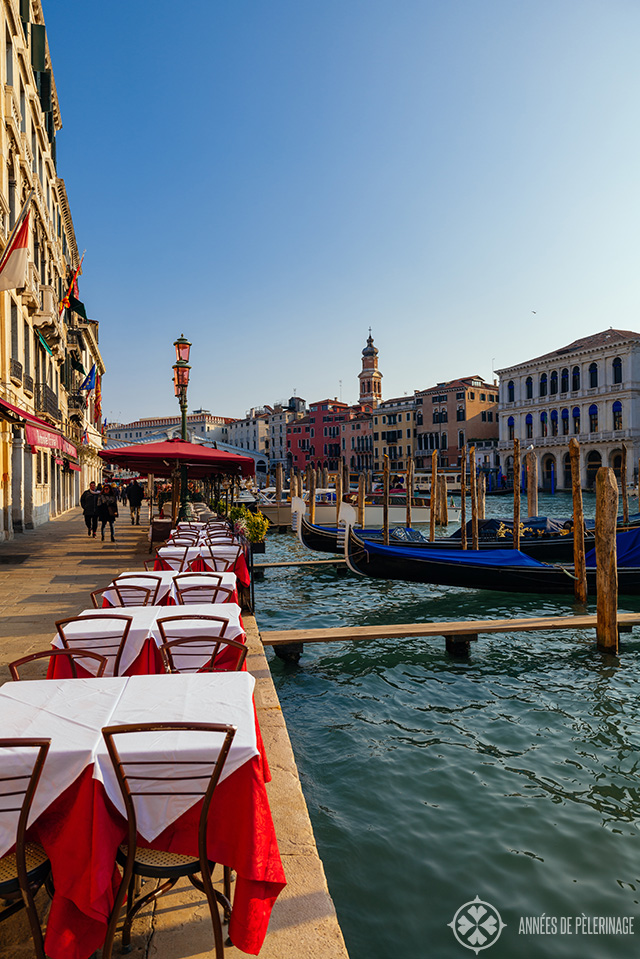
The best time to visit Venice is May when the temperatures are already warm but the city is not too crowded yet. April and October can be quite pleasant as well, though the weather will be a bit less favorable than in May.
I’d try to avoid the summer holidays, meaning July and August. It will be incredibly hot and crowded, and that combination is no fun. If you are visiting more than just Venice, then June and September can be a good alternative, as the temperatures are already warm enough to go swimming.
Winter is probably the worst time to visit Venice as it rains a lot and there is quite a high chance for floodings (Aqua Alta). It usually just lasts a couple of hours, but it’s still not pleasant. At the same time, the city is quite empty then and the frequent early morning fog creates quite a unique mood.
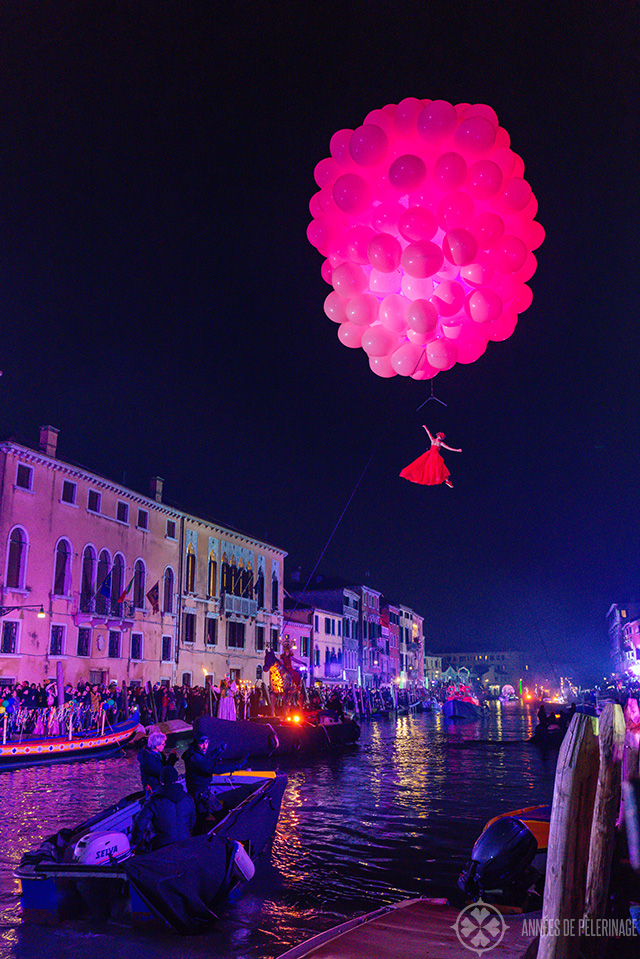
February is also the time of the Venice Carnival, which is actually my favorite time to visit. The weather situation can be quite tricky, but the atmosphere is just amazing.
Generally speaking, Saturday and Sunday are far more crowded than weekdays as a lot of Europeans (and Italians) use the weekend for a quick visit. I do promise you, though, that even on the rainiest and most crowded of days, Venice will still be beautiful!
I also wrote a guide comparing Rome vs Venice. In winter, it can be better to focus on the capital of Italy instead.
Where to stay in Venice
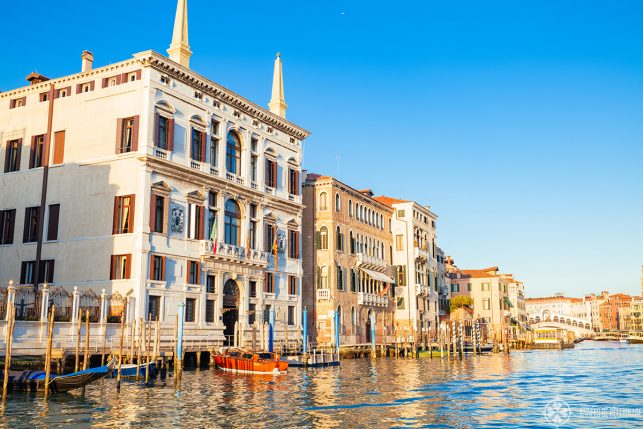
Venice is quite a compact city, so it really does not matter a lot where you stay. You will spend your days walking through the city anyway, and there is no major advantage in starting at one point over the other.
At the same time, do expect very high prices, so picking accommodation on the mainland or on Murano could be a smart move for those traveling on a tight budget. I love exploring Venice at night, so I generally don’t recommend it. But it remains an option.
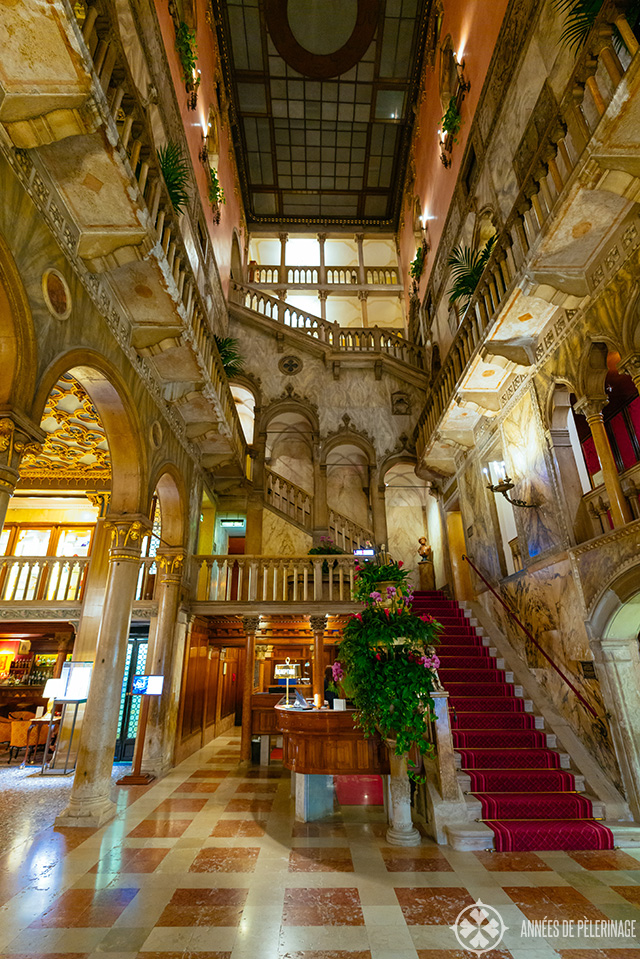
Also remember: In most hotels, the rooms with a view of the waterways are the most expensive, while the cheaper ones face to the back, which means that often picking a hotel at the Canal Grande has no advantage either.
I put together a detailed list of the best hotels in Venice for you.
Best luxury hotels in Venice (300€+ per night)
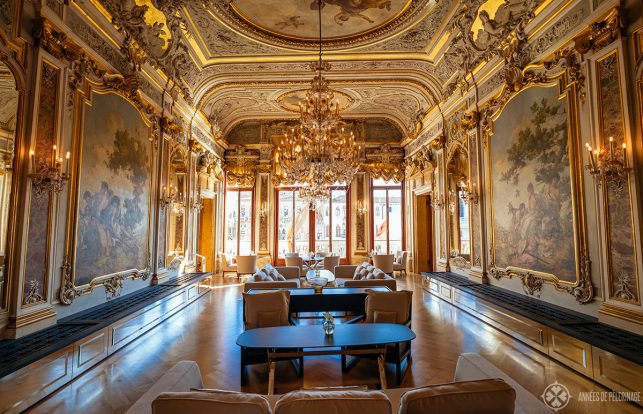
- Aman Venice (<- my favorite)
- Gritti Palace
- Hotel Danieli
- Belmond Cipriani
Mid-price hotels in Venice (~200€ per night)
- Grand Hotel Dei Dogi
- Hotel Ai Reali
- Ruzzini Palace Hotel
- Hilton Molino Stucky (cheaper cuz it’s on Guidecca)
Budget hotels in Venice (less than 100€ per night)
So, this was my little Venice travel guide. I hope I was able to help you plan your itinerary. Feel free to comment with your questions.
